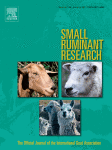Ver ítem
- xmlui.general.dspace_homeCentros Regionales y EEAsCentro Regional Buenos Aires SurEEA BalcarceArtículos científicosxmlui.ArtifactBrowser.ItemViewer.trail
- Inicio
- Centros Regionales y EEAs
- Centro Regional Buenos Aires Sur
- EEA Balcarce
- Artículos científicos
- Ver ítem
Changes in the aerobic vaginal flora after treatment with different intravaginal devices in ewes
Resumen
The objective of this study was to characterize the vaginal bacterial flora and subsequent pregnancy rates after AI in sheep subjected to 4 different estrous synchronization regimes – the use of two intravaginal devices (silicone or polyurethane sponges), and two different treatment periods (7 or 14 days). Twenty-one multiparous Texel ewes were randomly allocated to 4 treatment groups during the breeding season. In the ewes from Group I (n = 6) and Group
[ver mas...]
The objective of this study was to characterize the vaginal bacterial flora and subsequent pregnancy rates after AI in sheep subjected to 4 different estrous synchronization regimes – the use of two intravaginal devices (silicone or polyurethane sponges), and two different treatment periods (7 or 14 days). Twenty-one multiparous Texel ewes were randomly allocated to 4 treatment groups during the breeding season. In the ewes from Group I (n = 6) and Group II (n = 5), a polyurethane sponge containing 60 mg MAP was inserted in the vagina for a period of 7 or 14 days, respectively. In the ewes of Group III (n = 5) and Group IV (n = 5), an intravaginal progesterone releasing insert (IVP4) containing 160 mg of progesterone in an inert silicone device, was inserted for 7 or 14 days, respectively. At device withdrawal, each ewe was treated with 200 IU eCG i.m. Standard bacteriological procedures were performed on vaginal mucus samples obtained before the introduction of the devices, at device withdrawal and on the day of AI in all groups. Estrus was recorded with the aid of vasectomized rams every 12 h, and AI was performed 52–54 h after device withdrawal, using fresh semen. The intervals between device withdrawal and estrus were: Group I: 56.4 ± 21.5 h; Group II: 42.0 ± 33.9 h; Group III: 51.6 ± 21.5 h; Group IV: 37.2 ± 10.7 h, while the pregnancy rates were: Group I: 83.3%; Group II: 60.0%; Group III: 60.0%; Group IV: 60.0%. The pregnancy rates and the interval between device withdrawal and the occurrence of estrus did not differ between treatments. The predominant bacterial flora population at device insertion was mostly gram positive (G+) (90%) bacteria. The strains most frequently found were Bacilllus sp., Staphylococcus sp. and Corynebacterium sp. Of the 19 isolates made at device removal, 79% were gram negative, with the Escherichia sp. being the most frequently isolated. At the time of AI and regardless of the device used, the 14-day treatment group presented an initial gram positive bacterial flora, while the 7-day groups presented gram negative flora (82%). It could be concluded that the use of intravaginal devices, regardless of their composition (silicone or polyurethane), may generate changes in the normal vaginal bacterial flora of the vaginal mucus. These changes did not reflect on the subsequent fertility. The use of intravaginal devices should however include the adoption of strict hygiene procedures, to minimize the growth of bacterial flora.
[Cerrar]

Autor
Fuente
Small Ruminant Research 94 (1–3) : 201-204. (November 2010)
Fecha
2010-11
Editorial
Elsevier
ISSN
0921-4488
Formato
pdf
Tipo de documento
artículo
Palabras Claves
Derechos de acceso
Restringido
 Excepto donde se diga explicitamente, este item se publica bajo la siguiente descripción: Creative Commons Attribution-NonCommercial-ShareAlike 2.5 Unported (CC BY-NC-SA 2.5)
Excepto donde se diga explicitamente, este item se publica bajo la siguiente descripción: Creative Commons Attribution-NonCommercial-ShareAlike 2.5 Unported (CC BY-NC-SA 2.5)

